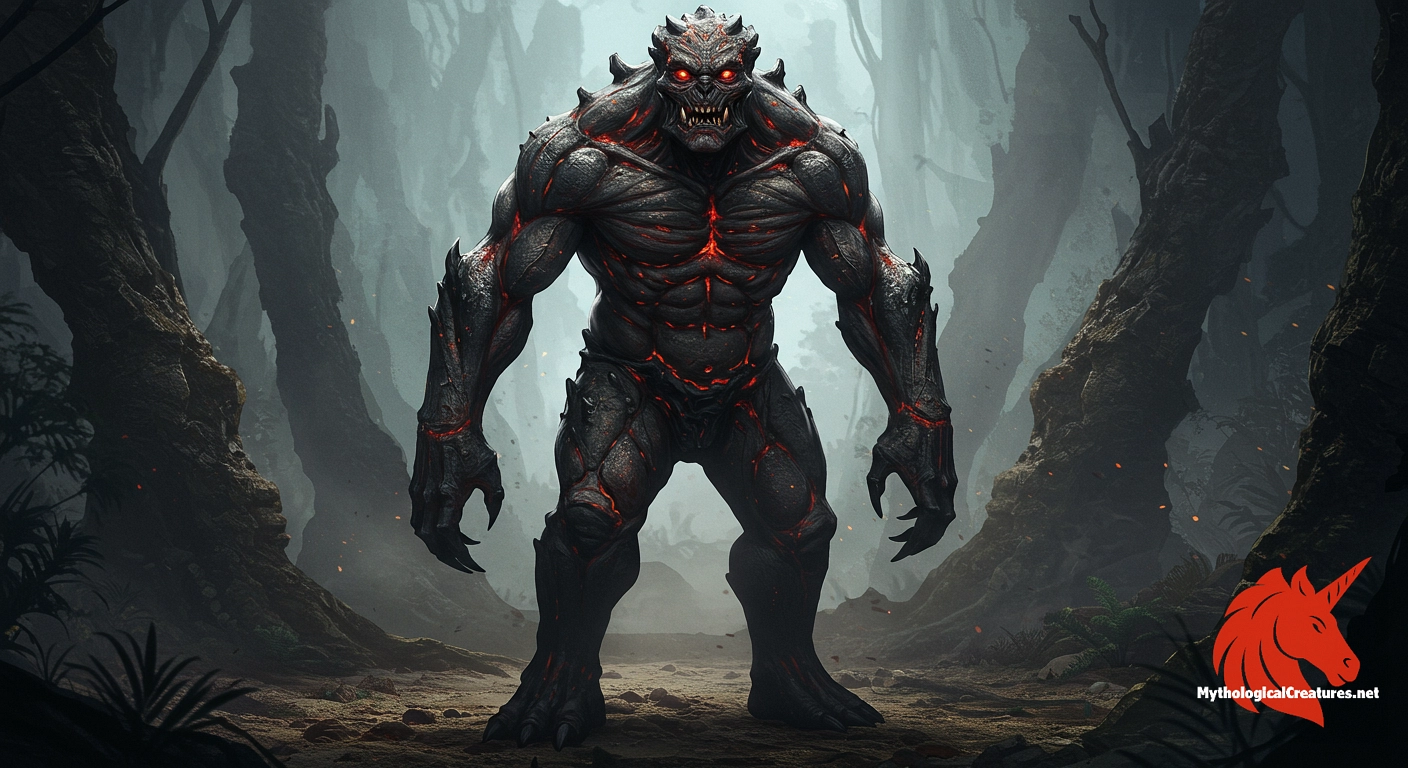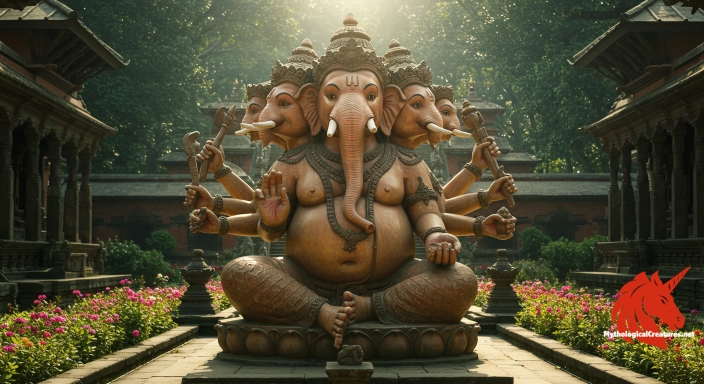Kroni: Kroni is the primordial embodiment of evil in Ayyavazhi mythology, manifesting through various demonic incarnations across ages.

Kroni
Kroni - Serves as the catalyst for divine interventions by Mayon, prompting the incarnation of avatars like Rama and Krishna to restore cosmic balance.
Origins & First Encounters
Kroni emerges in the rich tapestry of Ayyavazhi mythology as a primordial force of malevolence, embodying the very essence of cosmic evil. He is said to be the original miscreant, whose inherent darkness finds expression in numerous forms across different epochs. Hailing from ancient Tamil traditions, Kroni is deeply woven into the cultural narratives that explore the eternal struggle between good and evil. His first attestation appears in mythic accounts that intricately link him with the cyclical nature of the universe and its moral polarity. As a foundational antagonist, Kroni's influence is pervasive, symbolising the corruptive potentials that threaten divine plans. The mythology portrays him not merely as a single entity, but rather as a versatile presence that permeates various ages, or yugas, through distinct incarnations. His evolving persona reflects a complex interplay between human failings and supernatural intervention. His narrative is interlaced with themes of retribution, cosmic justice, and the transformative power of divine incarnations, underscoring his integral role in mythic history.
Source Texts & Tale Variants
The primary sources that recount the tales of Kroni include revered Ayyavazhi scriptures, which serve as the cornerstone for his mythic narrative. Ancient texts, transmitted orally before being documented, detail his origins and manifold incarnations, offering a glimpse into early perceptions of evil. Stories relating to Kroni have been preserved through traditional recitations and literary compilations that date back centuries in Tamil culture. Various narrative strands portray him as the progenitor of misdeeds by manifesting as notorious figures such as Ravana and Duryodhana. These textual sources are complemented by folklore that has adapted and embellished his character over generations. Some accounts integrate his legacy with broader Indian epic narratives, thereby expanding his influence beyond strictly Ayyavazhi conventions. In certain recitations, the adversarial confrontations between divine incarnations like Rama and Krishna and the manifestations of Kroni are highlighted with dramatic detail. The diversity in the narrative variants reflects the dynamic nature of myth-making and the adaptability of Kroni’s character within different cultural and historical contexts.
Form & Powers
Despite the scant explicit physical descriptions in the ancient sources, Kroni is often envisioned as an imposing and formidable figure whose appearance evokes dread and awe. His form, as rendered in various depictions, is fluid and mutable, reflecting his capacity to assume different monstrous avatars to suit the demands of the cosmic narrative. In many visual interpretations, Kroni is portrayed as vast and shadowy, with features that are deliberately exaggerated to evoke a sense of overwhelming malevolence. Artists and storytellers have imagined him with a distorted visage—marked by fierce, penetrating eyes and an array of horns or other demonic adornments—that symbolise his inescapable corrupt nature. His size is frequently described in hyperbolic terms, suggesting a grandeur that spans the realms of both the physical and the metaphysical. Details such as an aura of swirling darkness or a body shrouded in obscure, reddened mists contribute to his portrayal as an embodiment of chaos. These imaginative details, though varying across artistic traditions, serve to underline the inherent threat he poses to cosmic balance. Even in the absence of strict canonical features, his image is one of raw, unbridled chaos that stands in stark opposition to the harmonious order embodied by divine figures.
Regional Faces
The portrayal of Kroni is not uniform across the various regions that have embraced his myth, revealing fascinating local interpretations and stylistic variations. In the Tamil cultural sphere where Ayyavazhi originates, he is depicted with a particular emphasis on his primordial and perennial evil, serving as a counterbalance to the divine forces of Mayon. In contrast, in neighbouring regions and through the broader lens of Indian mythology, his characteristics are sometimes merged with those of other renowned demonic figures such as Ravana and Duryodhana. This blending results in a composite archetype that mirrors the local ethical and literary traditions. In regions where oral storytelling remains a potent medium of cultural transmission, Kroni's narrative adapts to contemporary settings, sometimes reflecting local societal challenges and moral dilemmas. Regional adaptations often incorporate distinct ritualistic elements, iconography, and linguistic nuances to render his persona more accessible and resonant with the local populace. The variety in regional depictions underscores the adaptability of his myth, allowing it to transcend geographical boundaries while retaining its core themes of conflict and moral duality. Such differential portrayals provide a richer understanding of how communities across different locales negotiate the concepts of evil and redemption.
Cultural Parallels
When viewed in comparative context, Kroni occupies a unique niche among the pantheon of mythological antagonists across cultures. His character is reminiscent of figures like Lucifer in Western traditions, who similarly embody the archetype of a rebellious spirit or fallen angel whose very existence challenges divine order. In many respects, Kroni shares the thematic space with other cosmic adversaries who personify evil, such as the Devil in Christian narratives and various demonic entities in Islamic lore. However, what sets him apart is the explicitly cyclical and incarnational nature of his evil, as he reappears in multiple avatars to test the resilience of virtuous forces. His recurring manifestations echo the perpetual struggle against chaos that is a common thread in mythologies worldwide. While some cultures focus on the singular fall of a once-exalted being, the narrative of Kroni emphasises the omnipresent and regenerative aspects of evil. This nuanced portrayal allows for a richer dialogue about the interplay between fate, free will, and cosmic retribution. Ultimately, Kroni serves as a point of convergence for cross-cultural mythic themes, offering insights into how diverse societies conceptualise and combat the forces that disrupt universal harmony.
Legacy & Modern Evolution
Over the centuries, the depiction of Kroni has evolved, reflecting shifts in religious thought, social consciousness, and artistic expression. Early mythic narratives cast him as a nearly insurmountable embodiment of evil, counterbalanced solely by the divine interventions of avatars like Rama and Krishna. In modern interpretations, however, Kroni’s figure has undergone a process of re-evaluation, with scholars and cultural commentators exploring his role as a symbol of both literal and metaphorical corruption. Contemporary retellings sometimes view his repeated incarnations as allegories for recurring cycles of human folly and the persistence of injustice. This evolution has allowed his myth to resonate with modern audiences, who see in him a reflection of the perennial battle between destructive impulses and the aspirational pursuit of moral order. His story has been reimagined in literature, theatre, and even visual arts, where his character is adapted to mirror contemporary struggles against systemic evils. The enduring legacy of Kroni serves as a reminder of the dynamic interplay between myth and culture, illustrating how ancient archetypes can be reinterpreted to address modern existential challenges. Today, Kroni remains a potent emblem of malevolence, one whose timeless narrative continues to inspire debate about the nature of evil in both historical and modern contexts.
Interesting Fact
It is notable that Kroni’s capacity to manifest in multiple forms mirrors similar mythological embodiments of evil across cultures, highlighting a universal archetype of primordial malevolence.
Quick Creature Info
Features:
Associations:
Our Mythic Legendary Rating:

Habitat:
Supernatural Powers:
Physical Attributes:
Abilities:
Behavior:
Lore:
References
Discover Another Mythical Legend You May Not Have Heard Of?
Uncover the mysteries of ancient folklore and expand your knowledge of legendary beings from cultures around the world.
Dare to Meet the Heramba....
Mythical Disclaimer: The images and data on this site are derived from various historical and literary sources, but we have found that many myths often have multiple versions and interpretations across references, sometimes contradictory. As a result, these creature depictions are artistic interpretations—imaginative blends of folklore, legend, and a dash of AI guesswork. Because creature descriptions vary widely, our illustrations and accompanying information represent our best effort to honor mythology while bridging creative gaps. Enjoy these interpretations—just remember, we've done our best to respect the stories and validate available data, but in the realm of mythology, details often shift, imagination leads the way, and nothing is ever set in stone!
Curated by the Mythological Creatures Team (rev. May 2025)
